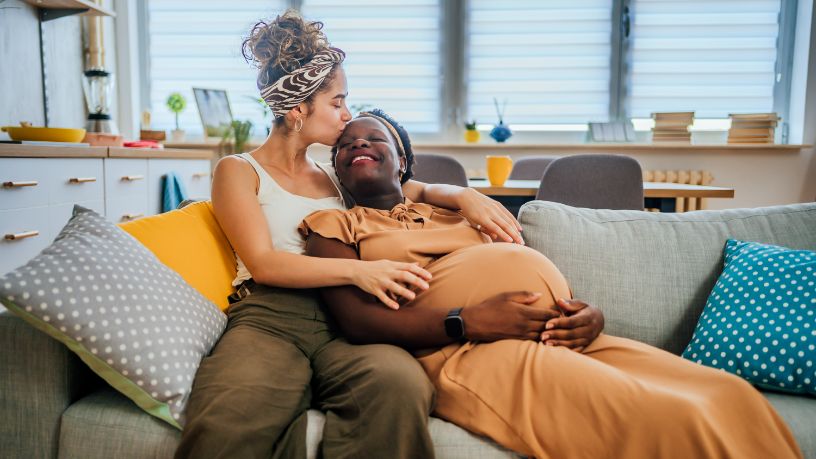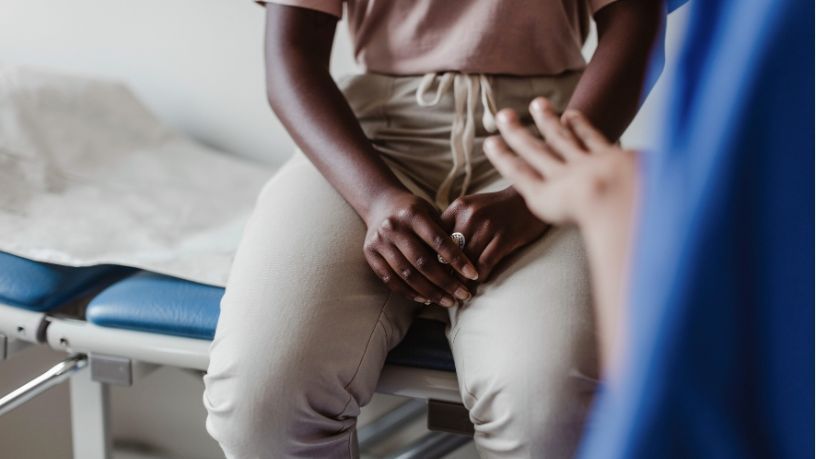Pain relating to endometriosis is often mistaken for common period pain.
Key takeaways
Endometriosis can impact fertility.
Speak with your GP for more information on treatment methods and managing symptoms.
Endometriosis is a long-term, progressive condition that affects around one in 9 Australian women and people assigned female at birth.1
Symptoms can vary widely. Some people may have no signs at all, while others might experience pain, heavy periods, or difficulties with fertility.
What is endometriosis?
Endometriosis (also known as ‘endo’) occurs when cells similar to the tissue that normally lines the womb (endometrium) grows in other locations.
This rogue tissue might appear in other parts of the reproductive system and on pelvic organs like the bladder or bowel, as well as on the ligaments that hold the pelvic organs in place.
Like endometrium cells, this tissue responds to the hormones released during a menstrual cycle when the womb is preparing for a potential pregnancy.
If a pregnancy doesn't occur, the misplaced tissue still bleeds but can’t fall away and leave the body through the vagina. Instead, it usually collects in the abdominal cavity, causing irritation and inflammation.
If left untreated, scar tissue can form, and pelvic organs may ‘stick’ to each other (form adhesions) and cause pain. The rogue cells can also spread to other parts of the body if they enter the bloodstream or lymphatic system.
Are you at risk of developing endometriosis?
We don’t know why endometriosis occurs, but a family history is a strong indicator for developing it.
Certain menstrual factors also seem to increase the chance of getting it, like starting periods early or having short cycles with heavy periods.
Not having a baby or having a first child after the age of 30 may also increase the likelihood of developing it.
Symptoms to look out for
The main symptom of endometriosis is pain, usually in the lower abdomen, pelvic region, lower back or legs.
This discomfort is often mistaken for period pain because it occurs or worsens around the time of menstruation.
Depending on where the endometrial tissue is located, people might feel pain during or after sex, when opening their bowels or when passing urine.
For some people, the pain can be severe. But that’s not related to how much rogue endo tissue there is. There can be a large amount of tissue and no symptoms, or a tiny amount and crippling pain. Endometriosis symptoms generally disappear after menopause when people stop menstruating.
Other symptoms include:
- unusual tiredness
- heavy, prolonged periods
- irregular periods
- difficulty getting pregnant.2
The importance of early diagnosis and active management
On average, there’s a seven year delay between the first symptoms and a formal diagnosis of endometriosis.3 For many people, the main problems are pain or difficulty getting pregnant.
Lower abdominal or pelvic pain can be seen as an unwelcome but normal part of the menstrual cycle, but it’s important to listen to your body and discuss any symptoms with a health professional. While there’s no cure for endometriosis, it can be treated. If you have symptoms, see a doctor.
How is endometriosis diagnosed?
A doctor will look for symptoms that suggest endometriosis, as well as checking for unusual swelling or tissue growth, by pressing on the abdomen or with an internal pelvic exam. Imaging tests may also help with a diagnosis.
A specialist may then need to confirm the diagnosis using a surgical procedure called laparoscopy. Under a general anaesthetic, the doctor inserts a thin, telescope-type device through the abdomen to check the areas of concern and take tissue samples for testing (biopsy).
A laparoscopy is a procedure with its own risks. The specialist will advise whether it’s needed, based on your symptoms and whether you’re trying to get pregnant.
Treating endometriosis
Your symptoms and their impact on daily life, along with personal preferences and priorities all play a part in the treatment plan.
Keep in mind that treatment might not be needed if symptoms aren’t bothering you and fertility isn’t a consideration. Before starting any treatment, it’s important to understand the risks and benefits of the different treatment options and discuss treatment goals with the doctor. Endometriosis has 3 types of treatments, which can be used alone or in a combination:
- medications
- surgical treatments (operations/procedures)
- complementary treatments (such as physiotherapy and psychology).
Medical treatments
Because the endometrium-like tissue is sensitive to period hormones, hormonal therapies may reduce pain and the severity of endometriosis by slowing its growth and stopping bleeding. Hormonal therapies include the oral combined contraceptive pill or progestogens (one of the 2 main female hormones), which can be prescribed as tablets, injections, or implants.
Pain-relief medications won’t alter the severity of endometriosis or stop it from progressing, but they can help manage the symptoms. Non-steroidal anti-inflammatories (NSAIDs) can be used alone or in combination with paracetamol, and stronger pain relievers may be prescribed in more severe cases.
A pain specialist may also be brought into help if pain relievers aren’t enough.
Surgical treatments
Surgery aims to remove as much of the endometriosis as possible and address any damage, like adhesions and scarring, caused by the condition. This can be achieved through a laparoscopy, or with a laparotomy which involves a single, larger incision, generally along the bikini line. Both procedures require a general anaesthetic and admission to hospital.
If medications and the usual surgical procedures haven’t worked, aren’t appropriate or it’s a choice not to try them, a hysterectomy (removing the womb) might be considered alongside the removal of any endometrial-like tissue.
Hysterectomy is a major operation and there’s no clear evidence on how well it works for managing endometriosis. It also removes the option of having children. Also, like the other surgical options, there’s no guarantee that the endometriosis won’t re-occur.
Complementary treatments
Allied health care professionals such as physiotherapists and psychologists can also be helpful in managing endo.
Physiotherapists may be able to identify muscular problems that could be contributing to the symptoms, while psychologists can assist with the emotions associated with living with endo and help with coping strategies.
Complementary treatments will not cure endometriosis, but they can help improve quality of life when used alongside medications and/or surgery.
It’s important to discuss complementary therapies with a doctor first, especially if trying dietary supplements or herbal medicines, as they may interact with endo treatments or have harmful side effects.
For more information about endometriosis, start by speaking with a GP. They’ll be able to help or provide onward referral to a gynaecologist for further assessment and support.
Resources
Endometriosis Australia provides more detail about living with endo, including links to support groups around the country and online information and resources.

At Bupa, trust is everything
Our health and wellbeing information is regularly reviewed and maintained by a team of healthcare experts, to ensure its relevancy and accuracy. Everyone's health journey is unique and health outcomes vary from person to person.
This content is not a replacement for personalised and specific medical, healthcare, or other professional advice. If you have concerns about your health, see your doctor or other health professional.
1Australian Government, Department of Health and Aged Care. (2024). What we’re doing about endometriosis. Australian Government, Department of Health and Aged Care.
2Mayo Clinic. (2024). Endometriosis. Mayo Clinic.
3Australian Government, Department of Health and Aged Care. (2024). Endometriosis and pelvic pain clinics. Australian Government, Department of Health and Aged Care.
You might also like...
Assisted reproductive technology: Why IVF has overtaken GIFT
Assisted reproductive technologies like IVF and GIFT have been helping people get pregnant for decades. But what’s the difference?
How to know when you're ovulating
If you’re trying to conceive, you may want to know when you’re ovulating each month. We look at the signs of ovulation and some ways to track your cycle.
5 ways women can support healthy ageing
Small changes to your daily life can have a big impact on your health as you age. Discover 5 ways to support women’s healthy ageing.
Cervical screening tests: Everything you need to know
From what happens on the day to what different results might mean, learn more about what a cervical screening test is.





